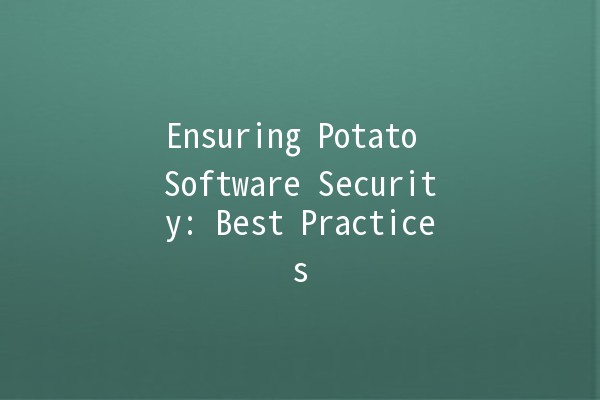In today's digital landscape, software security is paramount for protecting sensitive data and maintaining user trust. One software solution that has gained traction is Potato, a platform designed for various applications such as productivity tools, communication, and project management. This article delves into the importance of security in Potato software, offering practical tips to enhance its security measures.
Understanding Potato Software
Potato software is popular for its userfriendly interface and a variety of features that cater to individual users and teams. However, like any software, it is susceptible to potential security vulnerabilities that can jeopardize user data and overall system integrity. Understanding these vulnerabilities is the first step toward implementing robust security measures.
Why Focus on Security for Potato Software?

Stability and Security of Potato Software Features
Key Features of Potato Software
User Authentication: Robust authentication processes help prevent unauthorized access.
Data Encryption: Encrypting data in transit and at rest protects sensitive information from interception.
RealTime Monitoring: Continuous monitoring helps in identifying unusual activities that might indicate a security breach.
Potential Vulnerabilities
User Mismanagement: Insecure user practices, such as weak passwords, can compromise security.
Inadequate Updates: Failing to regularly update the software can leave it vulnerable to known security flaws.
ThirdParty Integrations: Integrating with less secure thirdparty applications can introduce vulnerabilities into your system.
Tips for Enhancing Potato Software Security
A strong password policy is essential for safeguarding user accounts. Users should be encouraged to create complex passwords, incorporating symbols, numbers, and varied case letters. Multifactor authentication (MFA) can provide an extra layer of security by requiring users to verify their identity through a secondary device or application.
Practical Example:
An organization using Potato software can implement enforceable password policies and employ MFA for all user accounts, reducing the risk of unauthorized access.
Regularly updating Potato software is crucial for addressing potential vulnerabilities. Developers frequently release patches that fix security flaws; failing to apply these updates increases susceptibility to cyber threats.
Practical Example:
Set a schedule for automatic updates for Potato software to ensure you are always using the most secure version available.
Creating frequent backups of data stored within Potato can be a lifesaver in case of data corruption or loss due to a security breach. Backup your data to secure, offsite locations or utilize cloud storage services for added safety.
Practical Example:
An organization can implement a policy to back up data weekly, storing copies in a secure cloud service to ensure data recovery if needed.
Data encryption works by converting data into a coded format, rendering it unreadable without the proper key or password. This method is vital for protecting sensitive information, especially when data is transmitted over the internet.
Practical Example:
Ensure all communication and data transactions conducted through Potato software are encrypted, which can be achieved through VPNs or SSL certificates.
Even the most secure systems can be compromised by human error. Conducting regular training sessions for employees can cultivate a securityconscious culture, equipping them with the knowledge to recognize phishing attacks and other threats.
Practical Example:
Implement quarterly training programs focused on cybersecurity best practices for staff members who regularly use Potato software, increasing overall organizational awareness.
Frequently Asked Questions
Common threats include phishing attacks, malware, unauthorized access through weak passwords, and vulnerabilities introduced by thirdparty integrations. Regular training and strong security measures can help mitigate these risks.
Implementing strong user authentication, regularly updating the software, utilizing data encryption, and conducting regular backups are effective strategies to safeguard your data.
Absolutely. MFA provides an additional layer of security beyond just passwords, making it significantly harder for unauthorized users to gain access to your accounts.
Yes, if you regularly back up your data, you can recover previous versions in the event of data loss, corruption, or a breach.
Many software applications, including Potato, strive to comply with industry standards such as GDPR, HIPAA, or PCIDSS to ensure user data protection. It's essential to verify these certifications for your reassurance.
Immediately change passwords, investigate potential unauthorized access, back up all necessary data, and ensure you assess overall system integrity. It’s also advisable to inform your IT team or consult a cybersecurity expert.
By implementing these practical strategies, individuals and organizations using Potato software can significantly enhance their security posture, helping to protect sensitive data and maintain user trust. Staying proactive in security measures not only mitigates risks but also fosters a more secure digital environment for all users.